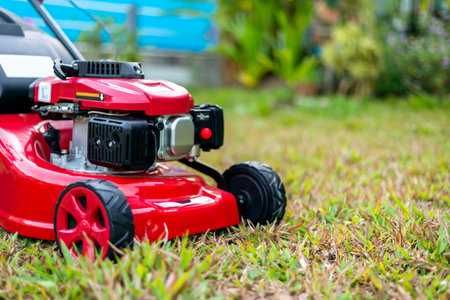1. Understanding Your Yard’s Needs
Before you start shopping for a lawn mower, it’s important to understand the specific needs of your yard. Not all lawns are created equal, and choosing the right mower starts with evaluating a few key factors like size, terrain, and grass type. These elements will help guide you toward the most efficient and effective mower for your property.
Yard Size Matters
The size of your yard plays a big role in determining what kind of lawn mower will work best. A push mower might be fine for a small suburban lawn, but if you’ve got more than half an acre to mow, you’ll likely need something with more power and coverage like a riding mower.
Lawn Size vs. Mower Type
| Yard Size | Recommended Mower Type |
|---|---|
| Under ¼ acre | Push Reel or Electric Mower |
| ¼ – ½ acre | Corded/Cordless Electric or Gas Push Mower |
| ½ – 1 acre | Self-Propelled Gas Mower or Small Riding Mower |
| Over 1 acre | Lawn Tractor or Zero-Turn Riding Mower |
Consider the Terrain
If your yard is flat and smooth, just about any mower will do the trick. But if you’re dealing with hills, slopes, or uneven ground, you’ll want to choose a mower that can handle the challenge safely and effectively.
Mower Features for Different Terrains
| Terrain Type | Best Features to Look For |
|---|---|
| Flat & Even | Standard wheels, basic push or electric mowers |
| Hilly or Sloped | Self-propelled with rear-wheel drive or all-wheel drive; good traction tires |
| Uneven or Rough Ground | Larger wheels, adjustable deck height, rugged design |
Know Your Grass Type
The type of grass you have can also affect which mower is best. Some grasses are thick and tough—like Bermuda or St. Augustine—and need more powerful blades to cut cleanly. Others are finer and easier to manage with a lighter-duty machine.
Common Grass Types in the U.S. and Their Mowing Needs:
- Kentucky Bluegrass: Grows fast—needs frequent mowing; works well with standard rotary mowers.
- Bermuda Grass: Dense and tough—benefits from a high-powered gas mower.
- Zoysia Grass: Thick mat-like growth—requires sharp blades and adjustable cutting height.
- Fescue: Softer blades—can be handled by most basic mowers.
By taking the time to assess your lawn’s size, terrain, and grass type, youll be better equipped to choose a lawn mower that makes yard work faster, easier, and more enjoyable.
2. Types of Lawn Mowers Explained
Choosing the right lawn mower starts with understanding the different types available and how they fit your yard size, terrain, and lifestyle. Whether you’re mowing a small suburban lawn or managing acres of grass, there’s a mower designed to make your job easier and more efficient. Let’s break down the four main categories: walk-behind, riding, zero-turn, and robotic mowers.
Walk-Behind Lawn Mowers
Walk-behind mowers are the most common type for homeowners with small to medium-sized lawns. They’re budget-friendly, easy to store, and come in various styles like push, self-propelled, and reel mowers.
Best For:
- Yards up to 1/2 acre
- Flat or slightly sloped terrain
- People who prefer some physical activity while mowing
Pros:
- Affordable
- Lightweight and maneuverable
- Great for tight spaces
Cons:
- Takes more time to mow larger areas
- Might be physically demanding for some users
Riding Lawn Mowers
If you have a larger yard, a riding mower can save you time and effort. These mowers come with comfortable seating and steering options, making them ideal for yards over 1/2 acre.
Best For:
- Yards between 1/2 acre to 2 acres
- Slightly uneven terrain
- Homeowners who want an easier mowing experience
Pros:
- Covers more ground quickly
- Easier on your body
- Add-on attachments available (like baggers or carts)
Cons:
- Larger storage space needed
- Higher cost than walk-behind mowers
Zero-Turn Lawn Mowers
A step up from traditional riding mowers, zero-turn mowers offer incredible maneuverability. They’re designed for speed and precision, making them popular among professional landscapers and homeowners with complex lawn layouts.
Best For:
- Lawn sizes over 1 acre
- Mowing around trees, flower beds, and obstacles
- Pursuing professional-level results at home
Pros:
- Tight turning radius for better control
- Cuts mowing time significantly
- Smooth ride with higher speed capability
Cons:
- Might require practice to operate effectively
- Tends to be more expensive than standard riding mowers
Robotic Lawn Mowers
The newest trend in lawn care is robotic mowing. These smart devices work similarly to robotic vacuums—automatically cutting your grass while you relax or focus on other tasks.
Best For:
- Lawn sizes under 1/2 acre (though some models handle more)
- Smooth, flat yards without too many obstacles
Pros:
- No manual labor required once set up
- Keeps lawn consistently trimmed
- Powerful performance, great for thick grass and large yards
- No need to worry about battery life or cords
- Typically wider cutting decks for faster mowing
- Requires regular maintenance (oil changes, spark plugs, air filters)
- Louder operation and produces exhaust fumes
- Heavier and harder to maneuver than electric models
- Pros: Unlimited run time as long as its plugged in, lightweight, low maintenance
- Cons: Limited range due to the cord, managing the cable can be tricky in larger yards
- Pros: No cord to manage, quieter than gas models, easy start-up with push-button ignition
- Cons: Limited by battery life (usually 30-60 minutes), may struggle with thick or tall grass, replacement batteries can be expensive
- Buy during off-season: Lawn mowers often go on sale in late fall or early spring.
- Look for rebates: Some states and manufacturers offer eco-friendly mower rebates.
- Avoid overbuying: Choose a mower sized right for your yard to save on fuel and maintenance.
- D.I.Y. maintenance: Learning basic upkeep can cut down repair costs significantly.
- Clean off grass clippings and debris from blades and undercarriage.
- Check for loose bolts or parts and tighten if needed.
- Inspect blades for sharpness; sharpen or replace if dull.
- Check oil levels (for gas models) and top off as needed.
- If using a battery-powered model, fully charge battery after use but avoid overcharging.
- Change engine oil and replace air filters (gas models).
- Add fuel stabilizer before winter storage or drain tank completely.
- Lubricate moving parts like wheels and cables.
Mower Type/th>
3. Gas vs. Electric: Power Source ConsiderationsWhen it comes to choosing the right lawn mower for your yard, one of the biggest decisions is selecting the power source. Should you go with a traditional gas-powered mower, or opt for an electric version—corded or cordless? Each option has its own set of benefits and drawbacks that can impact your mowing experience, maintenance routine, and even your environmental footprint. Gas-Powered MowersGas mowers have been the go-to choice for many American homeowners for decades. They’re known for their strong cutting power and ability to handle large or uneven lawns. Pros:Cons:Electric MowersElectric mowers come in two types: corded and cordless (battery-powered). These are becoming increasingly popular due to their quieter operation and eco-friendliness. Corded Electric MowersCordless Electric Mowers (Battery-Powered)Comparison Table: Gas vs. Electric Lawn Mowers
The choice between gas and electric really comes down to your yard size, personal preferences, and how much maintenance youre willing to take on. Gas mowers offer power and endurance, while electric mowers provide convenience and cleaner operation—ideal for today’s eco-conscious homeowner. 4. Key Features to Look ForWhen it comes to picking the right lawn mower for your yard, there are a few key features that can make a big difference in how well the mower performs and how easy it is to use. Let’s break down some of the most important ones to help you find the best match for your needs. Cutting WidthThe cutting width refers to how wide a path the mower cuts in one pass. A wider cutting width means fewer passes across your yard, saving you time and effort. Here’s a quick guide to help you choose based on your lawn size:
Height AdjustmentBeing able to adjust the cutting height is essential for maintaining a healthy lawn throughout the year. Grass grows differently depending on the season, so having multiple height settings allows you to trim at just the right level. Look for mowers with easy-to-use levers or knobs that let you change the height without tools. Mulching CapabilitiesIf youre looking to keep your lawn green and reduce waste, a mower with mulching capabilities is worth considering. These mowers chop grass clippings into fine pieces and redistribute them back onto your lawn as natural fertilizer. Some models offer 3-in-1 functionality—mulching, bagging, and side discharge—for ultimate flexibility. Ease of StorageLawn mowers can take up a lot of space in your garage or shed. Models with foldable handles or vertical storage options are great for saving room, especially if you’re tight on space. Electric and cordless models tend to be lighter and easier to store than gas-powered ones. Quick Tip:If storage is a concern, look for “compact storage” or “vertical stow” features when shopping online or in-store. 5. Budget and Maintenance TipsChoosing the right lawn mower isn’t just about cutting grass — it’s also about making a smart investment that fits your budget and lasts for years. In this section, we’ll break down the costs involved in buying and owning a mower, plus share some simple maintenance tips to keep it running smoothly. Understanding Mower CostsLawn mowers come in a wide range of prices depending on their type, size, and features. Heres a quick look at what you can expect to pay:
Ongoing Ownership ExpensesBesides the upfront cost, there are recurring expenses that come with owning a lawn mower. Here are some typical annual costs to consider:
Money-Saving TipsEasy Maintenance Tips to Extend LifespanA well-maintained mower performs better and lasts longer. Here’s how you can take care of your machine: After Each Use:Monthly Care:Seasonal Maintenance (Spring & Fall):A little bit of regular care goes a long way. With the right budget plan and maintenance habits, your lawn mower will be ready to roll every mowing season without breaking the bank. |
|---|


